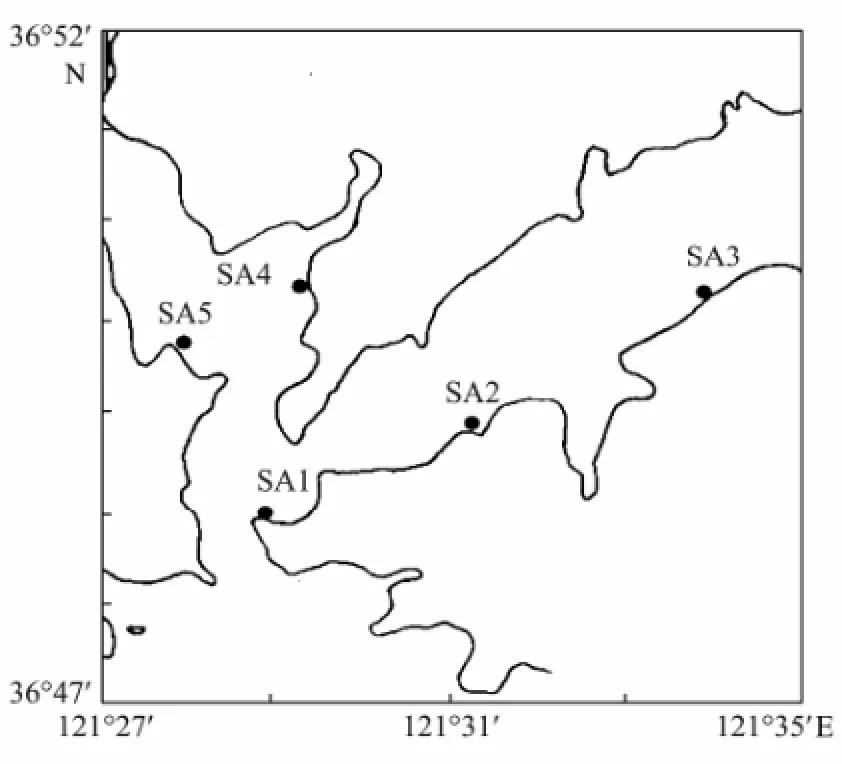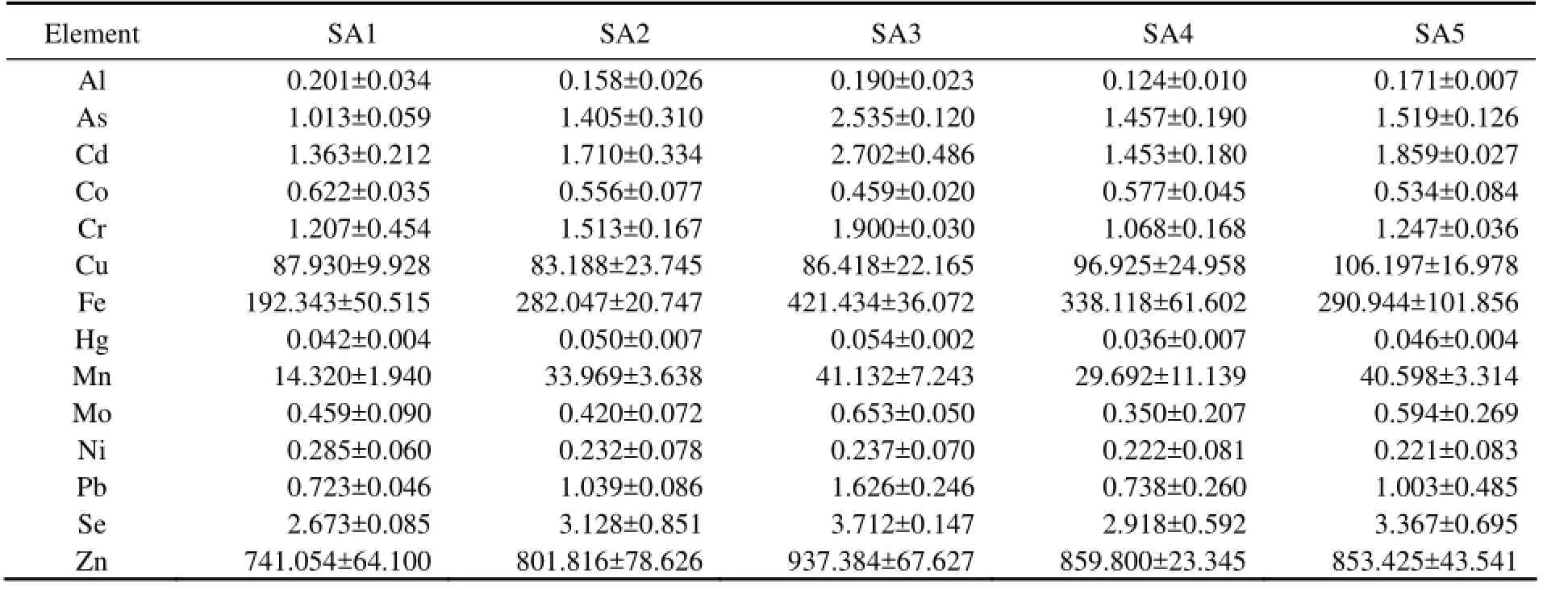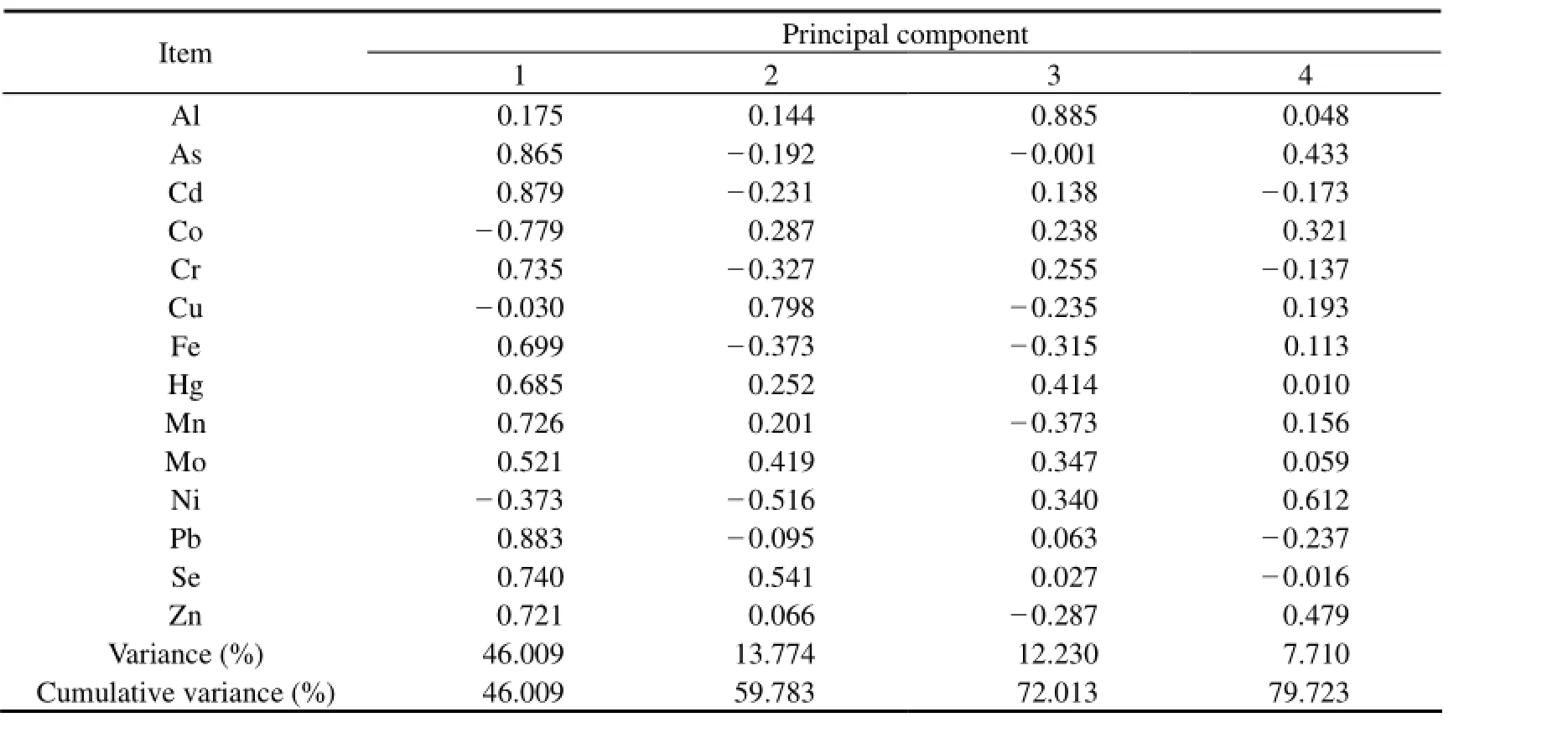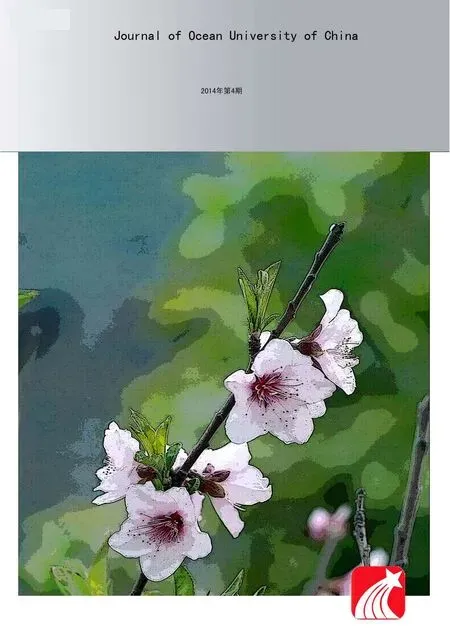Construction of Inorganic Elemental Fingerprint and Multivariate Statistical Analysis of Marine Traditional Chinese Medicine Meretricis concha from Rushan Bay
WU Xia, ZHENG Kang, ZHAO Fengjia, ZHENG Yongjun, and LI Yantuan,
1) Marine Drug and Food Institute, Ocean University of China, Qingdao 266003, P. R. China
2) College of Chemistry and Chemical Engineering, Qufu Normal University, Qufu 273165, P. R. China
Construction of Inorganic Elemental Fingerprint and Multivariate Statistical Analysis of Marine Traditional Chinese Medicine Meretricis concha from Rushan Bay
WU Xia1), ZHENG Kang1), ZHAO Fengjia1), ZHENG Yongjun2), and LI Yantuan1),*
1) Marine Drug and Food Institute, Ocean University of China, Qingdao 266003, P. R. China
2) College of Chemistry and Chemical Engineering, Qufu Normal University, Qufu 273165, P. R. China
Meretricis concha is a kind of marine traditional Chinese medicine (TCM), and has been commonly used for the treatment of asthma and scald burns. In order to investigate the relationship between the inorganic elemental fingerprint and the geographical origin identification of Meretricis concha, the elemental contents of M. concha from five sampling points in Rushan Bay have been determined by means of inductively coupled plasma optical emission spectrometry (ICP-OES). Based on the contents of 14 inorganic elements (Al, As, Cd, Co, Cr, Cu, Fe, Hg, Mn, Mo, Ni, Pb, Se, and Zn), the inorganic elemental fingerprint which well reflects the elemental characteristics was constructed. All the data from the five sampling points were discriminated with accuracy through hierarchical cluster analysis (HCA) and principle component analysis (PCA), indicating that a four-factor model which could explain approximately 80% of the detection data was established, and the elements Al, As, Cd, Cu, Ni and Pb could be viewed as the characteristic elements. This investigation suggests that the inorganic elemental fingerprint combined with multivariate statistical analysis is a promising method for verifying the geographical origin of M. concha, and this strategy should be valuable for the authenticity discrimination of some marine TCM.
Meretricis concha; traditional Chinese medicine; inorganic elemental fingerprint; multivariate statistical analysis; Rushan Bay
1 Introduction
The identification of the geographical origin of traditional Chinese medicine (TCM) is of great interest since it may provide a determinant for guarantee of quality (Li et al., 2006). Traditional the discrimination of geographical origin of TCM is processed by experienced herbalist doctors, which has greatly limited the modernization of TCM due to the problems of lower substandard codes and standards (Li et al., 2008). So far, fingerprint analysis of TCM has been employed to solve this problem. Compared with the number of studies dealing with the fingerprint of organic compounds (Xie et al., 2006; Qiu et al., 2007; Zhou et al., 2008), relatively few studies dealing with inorganic elemental fingerprint have been reported (Yan et al., 2008). However, many investigations reveal that the contents of inorganic elements in TCM, particularly marine TCM play an important role in biological activity (Wang et al., 1996; Wang et al., 1999; Zheng et al., 2011). Therefore, in recent years, significant developments have occurred in the construction of inorganic elemental fingerprint based on their contents (Chen et al., 2009; Ye et al., 2011), which is valuable for the identification of marine TCM’s geographical origin.
Meretricis concha, as a kind of marine TCM, is the shellfish of Meretrix meretrix Linnaeus according to the 2010 Edition of the Chinese Pharmacopoeia (National Pharmacopoeia Committee, 2010), which has been commonly used for its expectorant and antiasthmatic effects, as well as the treatment of scald burns. Until now, only a few studies deal with the M. concha’s elemental contents (Tan et al., 2011). To the best of our knowledge, the construction of M. concha’s inorganic elemental fingerprint has not been reported.
Considering the above facts, in the present work, the contents of 14 inorganic elements (Al, As, Cd, Co, Cr, Cu, Fe, Hg, Mn, Mo, Ni, Pb, Se, and Zn) from Rushan Bay have been determined by means of inductively coupled plasma optical emission spectrometry (ICP-OES), and the origin of the M. concha samples has been discriminated through hierarchical cluster analysis (HCA) and principle component analysis (PCA). The corresponding results demonstrate that the combination of inorganic elemental fingerprint and multivariate statistical analysis is a promising approach for verifying the M. concha’s geographical origin.
2 Experimental Details
2.1 Instruments
A microwave laboratory system, MDS-2003F from Xinyi (Shanghai, China) was employed for microwaveassisted digestion of theMeretricis conchasamples. Measurements by ICP-OES were carried out using a Perkin Elmer Optima 4300DV plasma emission spectrometer (Norwalk, CT, USA), equipped with an autosampler, TRACYC44, and a Meinhard nebuliser. Argon C-45 (purity higher than 99.995%), supplied by Ji’nan Gas Factory (Shandong, China), was used as plasmogen and carrier gas.
2.2 Reagents and Materials
Stock solutions of a multi-elemental standard solution (1000 μg mL-1) containing 26 elements (Al, As, B, Ba, Be, Ca, Cd, Co, Cr, Cu, Fe, Hg, K, Li, Mg, Mn, Mo, Na, Ni, Pb, Se, Sr, Ti, Tl, V, and Zn) dissolved in 5% HNO3were employed for calibration. 65% (w/v) HNO3and 30% H2O2were of reagent grade and nanopure water with a maximum resistivity of 18.2 m? cm-1, obtained from a Milli-Q Millipore system (Bedford, MA, USA) were used for sample treatment.
2.3 Samples
Meretricis conchasamples were collected from five sampling points in Rushan Bay, as shown in Fig.1. Among these sampling points, two points (SA1 and SA5) were located in the entry of the bay while the others were inside the bay. In each sampling point at least three samples were collected. Macroscopic identification was applied according to the 2010 Edition of the Chinese Pharmacopoeia.

Fig.1 The location of sampling points.
The plastic containers used for storing and treating the samples were cleaned to avoid contamination of samples due to traces of any metal. Containers were treated with nitric acid and were then washed with Milli-Q water.
2.4 Sample Pre-treatment
TheM.conchasamples were treated according to the following procedures. Soft tissue ofM.conchawas removed and the shellfish were carefully rinsed five times with Milli-Q water. The shellfish were then dried for 24 h at 80℃ to a constant weight and were grounded into fine powder. 0.500 g of the samples was accurately weighed inside Teflon digestion vessels, and 8 ml of concentrated nitric acid and 5 mL of H2O2were then added. Once the vessels were capped, they were placed in the microwave oven and the following program was run: step 1, 5 min to reach 100 ?C; step 2, 10 min to reach 140 ℃; and step 3, cooling down. After cooling to ambient temperature, the reactors were opened and sonicated to eliminate the nitrous vapours. The resultant solution (25 mL) was transferred into a plastic flask. Teflon digestion vessels were previously cleaned in nitric acid solution to avoid cross-contamination.
2.5 Determination by ICP-OES Method
The operating conditions of the ICP-OES equipment are summarized in Table 1. The calibration standards were prepared from a multi-elemental standard solution in 0.5% nitric acid.

Table 1 Operation Parameters of Optima 4300 DV
3 Statistical Analysis Methods
All statistical computations were performed with the statistical package SPSS 19.0 (IBM Corp., New York, United States). The software Origin 7.0 (OriginLab Corp., Massachusetts, United States) was applied to draw a line graph from the determined data.
HCA (Marengo and Aceto, 2003) of the samples was performed using the contents of the 14 inorganic elements as variables, the squared Euclidean distance as similarity measurement, and Ward’s method (Ward Jr., 1963) as amalgamation rule. PCA (Pearson, 1901; Jolliffe, 2004) was then applied to the data in order to assess the loading structure between the target elements.
4 Results and Discussion
4.1 The Construction of Inorganic Elemental Fingerprint
Rushan Bay, located in Shandong province, is one of theMeretricis conchaproducing regions. In order to investigate the relationship between the inorganic elementalfingerprint and the geographical origin identification ofM.concha, the elemental contents ofM.conchacollected from the bay were determined by means of ICP-OES, the elements involved being listed in Table 2. It can be seen that the elemental composition ofM.conchasamples can effectively discriminate regions of sampling. According to the results of quantitative detection by ICP-OES, 14 elements were filtered out to construct the inorganic elemental fingerprint. For convenience of drawing, the contents of some elements were amplified to achieve the same order of magnitude (10000-fold for Hg; 1000-fold for Al, As, Cd, Co, Cr, Mo, Ni, and Pb; 100-fold for Se; and ten-fold for Cu and Mn). In the present paper, the content curves of all the 14 elements were drawn in one plot for comparison, as is well shown in the following Fig.2.

Fig.2 The elemental contents of marine TCM Meretricis concha from five sampling points in Rushan Bay.
As is shown in the graph, the differences of the elemental contents can be seen clearly due to the differences of the sampling points, but the content of an individual element is always maintained within a certain range, therefore allM.conchasamples have the same peaks. Although the samples were collected in regions with different environment, the elements inM.conchasamples would maintain a certain balance. These facts support the application of inorganic elemental fingerprint for the determination of geographical origin ofM.concha.
Previously, Tanet al.reported the contents of 10 elements inM.conchafrom Guangzhou province by means of ICP-OES (Tanet al., 2011). Among them, the contents of the heavy metal elements Cd, Hg, and Pb are 0.500, 0.0413, and 1.000 mg kg-1, respectively, which are lower than those of the present results (the contents of Cd, Hg, and Pb are respectively 1.853, 0.0454, and 1.0406 mg kg-1), indicating that the pollution situation in Rushan Bay is more serious than in Guangzhou Province.
4.2 Hierarchical Cluster Analysis
In HCA, the similarity between samples is established using the distance concept, calculated from mathematical relationships between numerical properties of the samples. In an iterative procedure, each sample is linked to the closest sample or group of samples, and the characteristic distance is used to describe this union. The distance between groups of samples (commonly called classes or clusters) can be evaluated in different ways, and this is the main difference among common linkage methods. The group formation can be represented graphically in a dendrogram, which shows the different groups at a normalized or rescaled distance of each kind of samples from the others.

Table 2 The elemental contents (mg kg-1) in marine TCM M. concha from different sampling points
As can be seen from Fig.3, the 15 samples with the contents of the 14 elements as the clustering variable can be divided into two categories. Firstly, a cluster consisting of SA3 was obtained, followed by a second cluster of SA1, SA2, SA4, and SA5. Thus, all the five sampling points were discriminated according to the contents of 14 elements. In fact, the differentiation of the same marine biological samples by elemental content is influenced by environmental factors such as water chemistry and regional geology. Furthermore, the absorption mechanism and the state of elements also have strong effects on the contents of some elements. Therefore, the PCA was used to further study the identification of geographical origin of the marine TCMM.concha.

Fig.3 HCA dendrogram of marine TCM M. concha from five sampling points in Rushan Bay. The 15 M. concha samples are numbered starting from 1.
4.3 Principal Component Analysis
One purpose of PCA is to use fewer factors to explain more variables (Lin and Zhang, 2005). PCA was accomplished by factor analysis in SPSS software (Xu and Shao, 2006). Since the determined elements in the present research included macroelements and microelements, and their contents vary in orders of magnitude, the original variables were processed to be standardized firstly. PCA of samples was performed by using the contents of the 14 elements as the variables. According to the PCA results, listed in Table 3, the first four principal components (PC1 to PC4) contribute 46.009%, 13.774%, 12.230%, and 7.710% of the total variance, respectively. This result reveals that a four-factor model can explain approximately 80% of the data.
As is shown in Fig.4, the data were projected into the space of the first three PSs (72.013% variance retained), which provides a gross ‘overall picture’ among the elemental compositions of all theM.conchasamples assayed in the present study. According to the vectors listed in Table 3, the elements As, Cd, and Pb weighs highly in PC1; Cu weighs highly in PC2; Al offers the highest loading in PC3; and Ni shows higher weight in PC4. The main conclusion that can be drawn from the PCA results is that the origin of samples is the most influenced factor in the chemical composition of samples. Therefore, the elements Al, As, Cd, Cu, Ni, and Pb were selected to be the key variables to develop the discriminant models.

Fig.4 PCA scores of the 15 Meretricis concha samples in Rushan Bay based on the contents of the 14 inorganic elements.

Table 3 The four vectors and cumulative contribution of variance of the first four principal components
5 Conclusions
The aim of this paper is to explore the relationship between the inorganic elemental fingerprint and the geographical origin identification of M. concha. For that, the contents of 14 inorganic elements in marine TCM M. concha from five sampling points in Rushan Bay have been determined using ICP-OES. The classifications of the M. concha from five sampling points are accurate enough by means of HCA and PCA. A four-factor model which could explain approximately 80% of all the data has been established. Moreover, the elements Al, As, Cd, Cu, Ni, and Pb have been selected to be the key variables to develop the discriminant models. This investigation reveals that the combination of inorganic elemental fingerprint and multivariate statistical analysis is a promising approach for verifying the geographical origin of M. concha, and this strategy should be valuable for the authenticity discrimination of some marine TCM.
Acknowledgements
This project was supposed by the Program for Science and Technology of Shandong Province (2011GHY11521), the Department of Education of Shandong Province (No. J11LB07), and the Natural Science Foundation of Qingdao City (Nos. 12-1-3-52-(1)-nsh and 12-1-4-16-(7)-jch).
Chen, Y. X., Yu, M. G., and Xu, J., 2009. Differentiation of eight tea (Camellia sinensis) cultivars in China by elemental fingerprint of their leaves. Journal of the Science of Food and Agriculture, 89 (14): 2350-2355.
Jolliffe, I., 2004. Principal Component Analysis. Springer, New York, 150-165.
Li, N., Wang, Y., and Xu, K., 2006. Fast discrimination of traditional Chinese medicine according to geographical origins with FTIR spectroscopy and advanced pattern recognition techniques. Optics Express, 14 (17): 7630-7635.
Li, W. F., Jiang, J. G., and Chen, J., 2008. Chinese medicine and its modernization demands. Archives of Medical Research, 39 (2): 246-251.
Lin, H. M., and Zhang, W. L., 2005. The similarities and differences between Principal Component Analysis and Factor Analysis of SPSS software. Statistical Research, 3: 65-69 (in Chinese with English abstract).
Marengo, E., and Aceto, M., 2003. Statistical investigation of the differences in the distribution of metals in Nebbiolo-based wines. Food Chemistry, 81 (4): 621-630.
National Pharmacopoeia Committee, 2010. Chinese Pharmacopoeia. China Medical Science Press, Beijing, 916-918 (in Chinese).
Pearson, K., 1901. On lines and planes of closest fit to systems of points in space. Philosophical Magazine, 2 (11): 559-572.
Qiu, Y., Lu, X., Pang, T., Zhu, S., Kong, H., and Xu, G., 2007. Study of traditional Chinese medicine volatile oils from different geographical origins by comprehensive two-dimensional gas chromatography-time-of-flight mass spectrometry (GC×GC-TOFMS) in combination with multivariate analysis. Journal of Pharmaceutical and Biomedical Analysis, 43 (5), 1721-1727.
Tan, X. M., Wang, X. Y., Zhang, M. M., Zhang, W. X., and Wang, W. F., 2011. Determination of microelement of testacean Traditional Chinese Medicines. Chinese Journal of Experimental Traditional Medical Formulae, 17 (1): 61-63 (in Chinese with English abstract).
Wang, C. F., Duo, M. J., Chang, E. E., and Yang, J. Y., 1996. Essential and toxic trace elements in the Chinese medicine. Journal of Radioanalytical and Nuclear Chemistry, 211 (2): 333-347.
Wang, X., Zhuang, Z., Sun, D., Hong, J., Wu, X., Lee, F. S. C., Yang, M. S., and Leung, H. W., 1999. Trace metals in traditional chinese medicine: a preliminary, study using icp-ms for metal determination and as speciation. Atomic Spectroscopy, 20 (5): 86-91.
Ward Jr., J. H., 1963. Hierarchical grouping to optimize an objective function. Journal of the American Statistical Association, 58 (301): 236-244.
Xie, P., Chen, S., Liang, Y. Z., Wang, X., Tian, R., and Upton, R., 2006. Chromatographic fingerprint analysis—a rational approach for quality assessment of traditional Chinese herbal medicine. Journal of Chromatography A, 1112 (1): 171-180.
Xu, L., and Shao, X. G., 2006. Chemometric Methods. Science Press, Beijing, 67-85 (in Chinese).
Yan, L. N., Cheng, B., and Yao, S. Z., 2008. Study on element fingerprint of Chinese traditional herb by ICP-MS and AAS. Asia-Pacific Traditional Medicine, 4 (1): 26-29.
Ye, S. S., Yang, J., Liu, H. B., and Oshima, Y., 2011. Use of elemental fingerprint analysis to identify localities of collection for the large icefish protosalanx chinensis in Taihu Lake, China. Journal of the Faculty of Agriculture Kyushu, 56 (1): 41-45.
Zheng, K., and Yan, C. W., 2011. Application of ICP-AES with microwave digestion to detect trace elements in oysters from Jiaozhou Bay, China. Journal of Ocean University of China (Oceanic and Coastal Sea Research), 10 (3): 301-304.
Zhou, J., Li, Y., Zhao, J., Xue, X., Wu, L., and Chen, F., 2008. Geographical traceability of propolis by high-performance liquid-chromatography fingerprints. Food Chemistry, 108 (2): 749-759.
(Edited by Ji Dechun)
(Received April 23, 2013; revised May 16, 2013; accepted June 12, 2013)
? Ocean University of China, Science Press and Springer-Verlag Berlin Heidelberg 2014
* Corresponding author. Tel: 0086-532-82031695
E-mail: yantuanli@ouc.edu.cn
 Journal of Ocean University of China2014年4期
Journal of Ocean University of China2014年4期
- Journal of Ocean University of China的其它文章
- A Comparative Study of Intensive Litopenaeus vannamei Culture on Four Bottom Substrates Without Water Change
- Characterization, Expression and Function Analysis of DAX1 Gene of Scallop (Chlamys farreri Jones and Preston 1904) During Its Gametogenesis
- Secondary Metabolites of a Deep Sea Derived Fungus Aspergillus versicolor CXCTD-06-6a and Their Bioactivity
- Preparation, Characterization and Pharmacokinetics of Fluorescence Labeled Propylene Glycol Alginate Sodium Sulfate
- Early Development of Silvetia babingtonii (Fucales, Phaeophyceae)
- A Comparison of Different Gracilariopsis lemaneiformis (Rhodophyta) Parts in Biochemical Characteristics, Protoplast Formation and Regeneration
